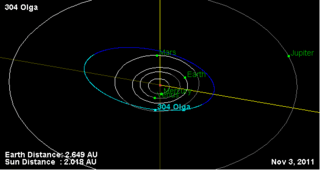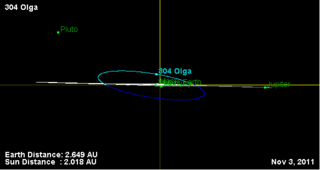304 Olga
| Discovery | |
|---|---|
| Discovered by | Johann Palisa |
| Discovery date | 14 February 1891 |
| Designations | |
| Main belt | |
| Orbital characteristics[1] | |
| Epoch 31 July 2016 (JD 2457600.5) | |
| Uncertainty parameter 0 | |
| Observation arc | 124.78 yr (45577 d) |
| Aphelion | 2.93719 AU (439.397 Gm) |
| Perihelion | 1.86853 AU (279.528 Gm) |
| 2.40286 AU (359.463 Gm) | |
| Eccentricity | 0.22237 |
| 3.72 yr (1360.5 d) | |
Average orbital speed | 18.974 km/s |
| 63.6148° | |
| 0° 15m 52.607s / day | |
| Inclination | 15.8530° |
| 159.080° | |
| 172.423° | |
| Earth MOID | 0.858818 AU (128.4773 Gm) |
| Jupiter MOID | 2.44982 AU (366.488 Gm) |
| Jupiter Tisserand parameter | 3.440 |
| Physical characteristics | |
| Dimensions |
67.86±2.1 km[1] 70.30 ± 2.32 km[2] |
| Mass | (1.15 ± 1.12) × 1018 kg[2] |
| 18.36 h (0.765 d) | |
| 0.0488±0.003 | |
| C | |
| 9.74 | |
|
| |
304 Olga is a large Main belt asteroid. It is classified as a C-type asteroid and is probably composed of carbonaceous material.
It was discovered by Johann Palisa on February 14, 1891 in Vienna.
304 Olga was identified as one of three asteroids that were likely to be a parent body for chondrites along with 449 Hamburga and 335 Roberta.[3] All three asteroids were known to have low-albedo (not reflect as much light) and be close to "meteorite producing resonances".[3] Chrondrites are the most common type of meteor found on Earth, accounting for over 80% of all meteors.[4] They are named for the tiny spherical silicate particles that are found inside them (those particles are called chondrules).[4]
- Orbit diagram
-

-

References
- 1 2 "304 Olga". JPL Small-Body Database. NASA/Jet Propulsion Laboratory. Retrieved 11 May 2016.
- 1 2 Carry, B. (December 2012), "Density of asteroids", Planetary and Space Science, 73, pp. 98–118, arXiv:1203.4336
 , Bibcode:2012P&SS...73...98C, doi:10.1016/j.pss.2012.03.009. See Table 1.
, Bibcode:2012P&SS...73...98C, doi:10.1016/j.pss.2012.03.009. See Table 1. - 1 2 Lunar and planetary science: abstracts of papers submitted to the ... Lunar and Planetary Science Conference, Volume 27, Part 1 - Lunar and Planetary Institute, Jan 1, 1996
- 1 2 ASU - Chondrites
External links
- 304 Olga at the JPL Small-Body Database

This article is issued from Wikipedia - version of the 9/10/2016. The text is available under the Creative Commons Attribution/Share Alike but additional terms may apply for the media files.